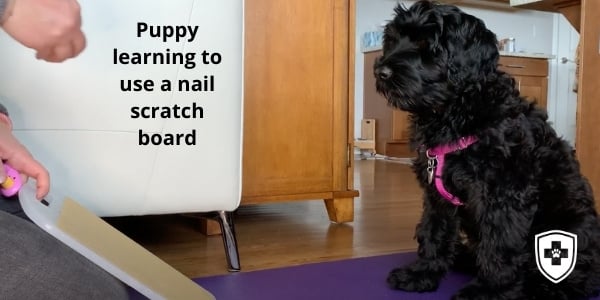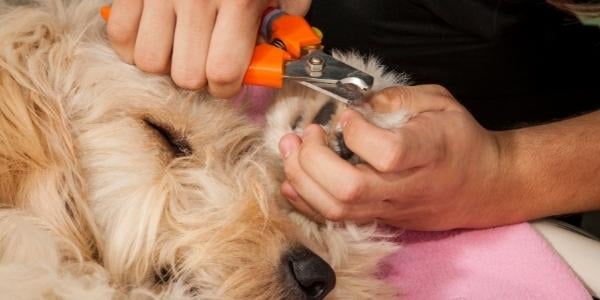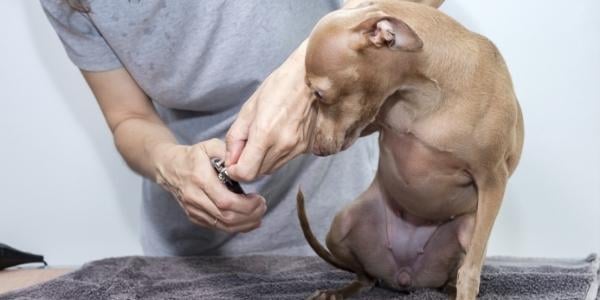 Trimming a dog's nails isn't something that most people are excited about doing. Dogs get stressed, won't stop moving or trying to pull their paw away, or become aggressive in their efforts to avoid a nail trim.
Trimming a dog's nails isn't something that most people are excited about doing. Dogs get stressed, won't stop moving or trying to pull their paw away, or become aggressive in their efforts to avoid a nail trim.
This makes the process dangerous for both the dog and the person trying to clip the nails, whether that's you, a groomer, or veterinary staff.
Correct nail length is crucial for your dog's mobility, grip, and skeletal structure. Not to mention that short nails mean fewer scratches on you or your hardwood floors.
Table of Contents
It's important to teach a dog to stay calm during nail trims because it's easy to cut the nail too short, "quicking" the nail, which is quite painful for the dog. And if a dog learns that nail trims cause pain, they are likely to avoid or make a big fuss about them in the future.
For puppies: Introducing nail trims in a calm and positive way to a new puppy will make lifelong nail care easier, safer, and less stressful. The sooner you can introduce them to nail trims, the better!
For adult dogs: If you have an adult dog who already doesn't like nail trims, you can still follow the same steps outlined below – it may take a bit longer than a brand new puppy – and I have tips for what to do in the meantime as well.
Even if you know you won't be trimming your dog's nails yourself, that's okay! If you practice the steps below without actually trimming any nails, your dog's groomer will have an easier time, and your dog will be less stressed because they are familiar with the process and tools.
How to Help Your Dog Feel Comfortable with Nail Trims
The name of the game is to go slow and create incredibly positive associations!
You will not – and should not – trim your puppy's nails the first time they see the nail clippers. Our goal is to create a positive emotional response whenever the clippers appear and reinforce calm and cooperative behavior throughout the process.
What You'll Need:
- Dog nail clippers
- High-value dog treats (chicken, cheese, freeze-dried treats)
- A comfortable place for your dog to settle, such as a bolster bed
- A relaxed dog — don't try to do this training exercise when they are full of energy and ready to play
What Type of Nail Clippers Should You Use for Your Dog?
Be sure to choose nail clippers based on the size of your dog's nails and what feels most comfortable for you to use.
For small dogs and puppies, you may prefer to use scissor-style clippers. Human nail clippers will do, and they're quiet.
For larger dogs or for those with thick nails, these nail clippers from Miller's Forge are our team's top pick.
Introducing Nail Trims to Your Dog Using Conditioning
Do this training exercise when your dog is resting, sitting, or standing comfortably.
I prefer to trim my dogs' nails when they are lying on their sides, but I know others prefer to trim a dog's nails when they are standing or sitting. Practice in the way that best suits your goals and your dog's comfort. Each session should last only a minute or two at a time! Try to get in one or two sessions per day.
Steps for Helping Your Dog Love Nail Trims
You might want your dog to LOVE getting their nails trimmed, but because keeping nails short is so important for their overall comfort and health, having your dog comfortably tolerate nail trims is just fine. Use these steps to get them acclimated.
Step One: Start with the nail clippers tucked away in a pocket or held out of your dog's sight, such as behind your back. Show your dog the clippers and then grab a treat and reward them. Hide the clippers from sight. Repeat.
Don't push the clippers too close to your dog; simply let them look at them from afar at first. The timing is important here! The clippers must predict the treat happening, not the other way around. Be sure your dog sees the clippers before reaching for the treat.
Step Two: Now, you're going to add reaching for and holding your dog's paw to the process. Show your dog the clippers, reach for and gently lift and hold your dog's paw, then treat. Hide the clippers and repeat! If your dog is pulling their foot away from your hand or trying to avoid having their paw touched and held, you can separate paw handling as its own exercise until they are more comfortable.
Step Three: As long as your dog isn't showing signs of wanting to avoid the clippers, you're ready to add on another layer to this process. You'll still start with the clippers behind your back or out of sight. Bring the clippers out so your dog can see them and reach them closer to your dog's paw. You don't have to touch the clippers to their nail quite yet! Reward with a treat, then hide the clippers out of sight again. Repeat.
Step Four: Add in another layer of the process. Bring the clippers out from behind your back, and reach to touch them to one of your dog's nails. Just lightly rest it on the tip of the nail for a second so your dog can get familiar with what it feels like. Give them a treat, and then hide the clippers. Repeat!
As long as your dog is relaxed and not trying to pull their toes away, you can start lightly touching more than one nail at a time before giving them a treat. For example, you may touch all four nails on a paw before the reward.
Step Five: When your dog is comfortable with the first three steps, it's time to add actual trimming of a nail. When first starting this step, don't try to trim a lot off of a nail on the first try. Just trim the very tip of the nail and then give your dog a treat. There is no rush to get all the nails done in one sitting.
This video shows the below steps in action:
Bonus Step: I like to add a step for helping your dog get used to the sound of the *CLIP*, so they don't startle when you actually trim a nail for the first time. This also helps you get more comfortable with using the clippers. I typically do this between step two and three.
Grab an uncooked spaghetti noodle (elbow macaroni also works) to use as the thing to "trim," as this mimics the sound of nail trimming quite well. Clip the noodle, then give your dog a treat. Repeat!
Here's a video of the amazing Laura Monaco Torrelli showing how she does this step:
Getting Your Dog Used to Nail Grinding
If you prefer to grind your dog's nails with a grinding tool like a Dremel, acclimating your dog to tolerate this follows the same steps as regular nail trimmers above. Check out the process in this video:
A grinding tool can be quite loud and feels very different when applied to a nail. Here are some tips to help acclimate your dog to nail grinding:
- Desensitize your dog to the sound of the grinder. Turn it on at its lowest speed, give your dog two or three treats, then turn it off. Repeat at varying speeds, so your dog learns to associate that sound with good things happening to them.
- Introduce the feeling of the vibration by adding a step of touching the base (non-grinding side) of the Dremel to your dog's paw briefly, then giving a treat.
- When first practicing touching your dog's nail with the Dremel, do so with it turned off before working up to turning it on and then briefly touching your dog's nail.
- Work slowly on increasing the duration of the grinding. One nail per training session is just fine until your dog is fully comfortable with the process.
Safety Tip for Grinding Your Dog's Nails: If you have long hair, make sure your hair is pulled back – ideally in a bun. Trust me, the last thing you want is for your hair to get caught in the Dremel.
It happens more than you think and untangling it is painful or close to impossible. I've helped quite a few groomers try to detangle that mess before we had to reach for the scissors. I don't want you to have to cut your hair!Be careful if your dog has long fur that could be tangled in the Dremel as well, whether on their legs, their tail, or on their paw pads.
Here is a video of Preventive Vet team member Anne using a dremel to trim Clover, the Portuguese Water Dog's nails. As you can see, Clover is as relaxed as can be, and her nails (and Anne's) look great!
Should You Use a Clicker or Marker Word for Nail Trims?
You most certainly can integrate a clicker or marker word to train your dog for nail trims!
The steps outlined above are focused on classical conditioning – simply pairing the experience of having nails trimmed with positive things. It's not required, but if your dog is familiar with marker training, it can be really helpful to mark with a "yes!" or click for cooperative behaviors in each step.
You may notice in the bonus step video above that Laura is using a tongue click as her marker, letting the dog know that she is getting a treat reward.
Your marker or click points could include:
- Your dog laying down or sitting at the start of the nail trimming session
- Staying in the sit or down and calmly looking at the clippers when you present them
- Offering a paw and holding it there while you touch the clippers to their nail
- After each nail is trimmed
- After all nails on one paw are trimmed
Signs Your Dog Is Stressed During Nail Trims
If you notice your dog exhibiting the subtle body language signals listed below, it's best to stop and take a break from nail trimming.
If we ignore these subtle signs of stress or nervousness, a dog may escalate to more aggressive behavior, like biting, in an effort to make the unpleasant experience stop. Go back in your conditioning steps to where your dog is more comfortable and work up from there.
Watch for these signs of stress:
- Turning their head away (avoiding)
- Licking their lips or flicking their tongue
- Yawning
- Paw lift or paw pulling away
- Trying to curl up in a ball or tucking their feet under their body
- Wide eyes (whale eye)
- Shaking or trembling
- Tail tucked
- Ears flat
- Mouthing at your hand or the clippers
- Whipping their head around to the clippers
If your dog exhibits more obvious signs of stress, like growling, snapping, or biting, please connect with a certified dog trainer or behavior consultant to help you personalize the nail trim counter conditioning plan and ensure safety during the process.
Need professional help for your dog's nail trim training?
Connect with me for virtual one-on-one coaching sessions for support and get a behavior plan specific to your dog and goals.
What if Your Dog Hates Having Their Nails Trimmed?
Use a Nail Scratch Board
This is my absolute favorite way to maintain shorter nails for dogs who hate getting their nails trimmed! I made my own nail scratchboard by adhering a small square of fine-grain sandpaper to a solid cutting board (used by a team member in the photo below).

It's a pretty quick process to teach a dog to scratch the board and file down their nails on their own. This video explains the process and features more than a few of the Preventive Vet dogs catching on to this training skill really quickly:
Scratch boards are a bit trickier to use for your dog's back paws. Here's a video showing how to use stairs as a way to train this:
Which Is the Best Nail Tool to Use with My Dog?
Nail Scratch Boards
Nail scratch boards are best for:
- Dogs who are extremely nervous or reactive to clippers or grinders
- People who are extremely nervous about clipping or grinding their dog’s nails
- Maintaining nail smoothness between trimming sessions
Pros:
- Gentle and less likely to cause splintering
- Provides better control over nail length
- Suitable for dogs that are anxious about the noise of clippers or grinders
- Easy to train a dog to use for their front paw nails
Cons:
- Requires more time and effort compared to clippers or grinders
- Not ideal for significantly overgrown nails
- Difficult to train a dog to file down their back paw nails
- Overuse can irritate paw pads
Dog Nail Clippers: Classic and Reliable
Clippers are best for:
- Regular maintenance trimming
- Quick and efficient nail trimming sessions
Pros:
- Quick and effective, especially for dogs with thicker nails
- Available in various sizes and designs for different nail types or user preferences
- Suitable for dogs with nails that have veered into "overgrown" territory
Cons:
- Prone to causing splintering or discomfort if used incorrectly
- Some dogs might be anxious due to the pressure or sound of clippers
- Clipper design (especially guillotine styles) can make cutting a nail too short easy to do
Grinders (Dremel): Precision with Patience
Grinders are best for:
- Dogs with black nails, where the quick is harder to identify
- Gradual and precise nail shortening
- Dogs that tolerate vibrations and noise
Pros:
- Allows for gradual trimming, reducing the risk of cutting the quick
- Smooths nail tips, reducing the chance of splintering
- Suitable for shaping and rounding edges
Cons:
- Requires acclimatization to the noise and vibrations
- Can be time-consuming due to the gradual approach
- Some dogs might be uncomfortable with the sensation of the grinder
Choosing the right tool to trim your dog’s nails can be a game-changer in creating a positive experience for both of you. Scratch boards, clippers, and grinders each have their own strengths and weaknesses, and the decision ultimately depends on your dog's size, temperament, and your comfort level. If your dog is extremely anxious, starting with a nail scratch board might be a good first step. For more efficient trimming, clippers might be your best option. If precision is essential or if your dog has black nails, nail grinders offer a controlled way to trim gradually.
Remember, patience and positive reinforcement are key regardless of the tool you choose.
Just One Nail a Day!
There is no rule that you have to trim all of your dog's nails in one sitting! If you can get just one nail trimmed a day, that's okay. It's preferable over trying to get all of them done and your dog having a traumatic experience in the process. That only makes future nail trims more difficult.
Keeping Your Dog Distracted
Distracting your dog with a smear of peanut butter or a stuffed food toy while you trim a nail is an option for dogs who do not exhibit aggressive behavior during nail trims. This is different than actively training your dog to be a cooperative participant in nail trimming – you really are just trying to keep their focus on something super yummy while you get one or two nails clipped.
Distractions are best used for dogs that otherwise might wiggle around or get uncomfortable being restrained. It's best to have a helper who can distract your dog by continuously giving treats. Or, if no helper is available, use a lick pad stuck to the wall or dishwasher at your dog's nose level or place a stuffed food puzzle, like a Toppl or KONG, in their food bowl for them to lick at.
Be aware of what your dog can tolerate, even while distracted! Only do a couple of nails if that's all they can handle at the moment.
Safety First! Recently there was a popular distraction method for nail trims that went viral on social media. It basically was wrapping cellophane around your forehead, smearing peanut butter on it, and then have the dog lick it while you're bent over trimming their nails. THIS IS DANGEROUS!
If your dog feels frightened, nervous, or you accidentally quick their nail, your face is at risk of being bitten. It also takes away your ability to keep an eye on the rest of your dog's body language. When using distractions for nail trimming, be sure that your dog's head is pointed away from yours – working from the side is best.
Change Up Your Nail-Trimming Tools
If your dog has a negative association with nail clippers, you can reset and start conditioning them to a nail grinder (like a Dremel) instead. Some dogs do better with different nail-trimming tools. Be sure that you spend the time creating a positive association with the new tool before trying to use it on your dog's nails. Go at their pace!
Are Grooming Slings or Hammocks Okay to Use for Trimming Your Dog's Nails?
I do not recommend using a sling to hold your dog up while you trim their nails. Many dog owners believe that because their dog is still and not wriggling around, this means they are calm and "just fine" with what's happening.
In my experience seeing dogs in hammocks, most of these dogs are simply shut down, helpless, and stressed. It also takes away your dog's sense of agency and choice in the procedure. How would you feel if you were wrapped in a straightjacket and suspended for someone to trim your toenails? I much prefer a nail scratchboard to use in the meantime while working on the conditioning steps for nail trims outlined above.
However, if a grooming hammock makes it physically easier for you to trim your dog's nails, spend some time acclimating your dog to being in the hammock and create those positive associations with being suspended. Don't just throw them in it from the get-go. And be sure to use a grooming hammock rated for your dog's size and weight.
Helping your dog get used to nail trims takes time and patience! You may feel like it's urgent to trim your dog's nails and just "get it done," but this usually isn't the case. If your dog's long nails are extreme and directly affecting their gait and health, connect with your veterinarian to discuss whether it's something they can do during a vet visit with appropriate low-stress handling techniques or with helpful sedatives on board for the appointment.





